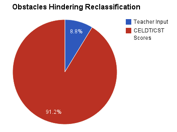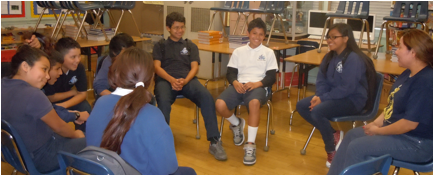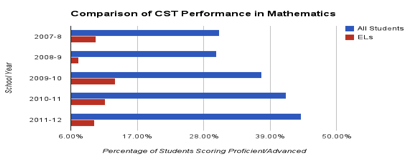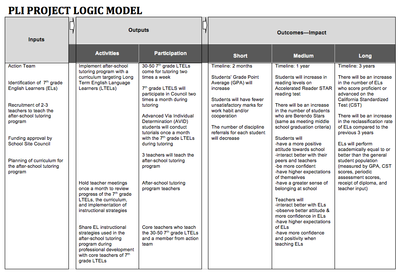Tutoring for Long Term English Learners
The leadership project, through an after school tutoring program, focused on helping Long Term English Learners reclassify. The program focused on developing test-taking and critical thinking skills, with an emphasis on community building, in order for the students to feel a sense of belonging and develop more self-confidence at school.
 Problem and Rationale
Problem and Rationale
The objective of this project was to increase the reclassification rate of Long Term English Learners (LTELs) at Berendo Middle School (BMS) in order help them achieve academic success. Although students at BMS are promised an education that will enable them to meet or exceed California State Standards, this has not been provided for the LTELs. A substantial gap exists between the performance of the general student body in comparison to the English Learners (ELs), even in subject areas outside of English Language Arts. For instance, during the 2010-11 school year, 41.7% of the entire student body scored proficient or advanced on the Mathemathics section of the California Standards Test (CST) compared to only 11.7% of ELs. Additionally, most of the LTELs are programmed into lower-track courses where less content is covered and teacher expectations are low, and consequently fall further below grade level; through an initial teacher survey, it was found that at BMS, the majority of the teachers' perceptions about the ELs were negative regarding both academics and social skills. If left as is, these students will not be able to reclassify, which in turn will result in them already being behind their peers as they enter high school. More importantly, the majority of these students will not receive the education necessary to pursue higher education, or even graduate high school, which will close many doors of opportunities in their future.
My role in the program was to establish and run the tutoring program; this included activities such as recruiting members to join the action team, providing materials, modeling lessons, collecting data, organizing meetings, and providing the time and place to analyze the data.
Predictions: LOGIC MODEL
As an action team, we predicted that having an after-school tutoring program for LTELs using a curriculum based on effective EL strategies attained from research, with a focus on critical thinking and test-taking skills, would increase grades in their core classes, increase their reading level, increase CST scores, and increase the rate of reclassification at BMS. In addition, we thought that forging a relationship with English teachers to implement the same strategies would provide consistency much needed by the LTELs. Furthermore, we anticipated that using Council to build a learning community for them would lead to a more positive interaction of LTELs with peers and teachers, which would then improve their sense of belonging at school and boost their overall confidence. Lastly, we expected that inviting Advanced Via Individual Determination (AVID) students to conduct tutorials, which is an AVID strategy that requires students to help each other with confusions through inquiry, would help ELs develop critical thinking skills, make connections with peers who could serve as role models, and strengthen the LTELs’ ability to have sophisticated discourses with peers.
Challenges and Changes
The key components of the tutoring program were implemented as planned, with the exception of collaborating with the English teachers to utilize the same strategies during the regular school day. There were various contributing factors to this alteration, but the biggest reason was lack of time and funding that were necessary to provide coverage in order to visit classrooms to model the strategies; additionally, some teachers were unwilling to cooperate.
As the program was being implemented, the action team faced several challenges. First and foremost, encouraging students to consistently attend tutoring after school was difficult, especially towards the latter weeks of the program. The team had to devise incentives and also request assistance from the English teachers in the form of extra credit and consequences. Students looked forward to facets of the program such as Council and tutorials, but it was insufficient to retain all the students; hence, motivation was a discussion focus during the action team's weekly meetings, and an assortment of methods were attempted. In the end, however, the team concluded that helping students recognize the value of learning was the most powerful tool. Another obstacle we faced was making certain that weekly observations were conducted by the designated action team members to ensure its fidelity. The coordinators had other priorities after school, and I found myself in classrooms modeling lessons and overseeing activities, which permitted very little time to visit classes solely for the purpose of observation. The team had to reduce observations to twice a month. Lastly, the meticulous nature of collecting, updating, and analyzing data was laborious, and there were so many variables that affected the data, that at times, our team questioned its validity; we had to keep in mind that our focus was not on the data itself, but in utilizing it to improve our program. As a matter of fact, the qualitative data from the observations and student work became the most valuable to the team. We were confronted by countless other impediments, but the ones mentioned above were the most crucial to the success of our program.
Main Activities
- Recruitment of action team—3 teachers, principal, Title I Coordinator, & Title III Coordinator
- Presentation of Rationale, Purpose & Plan of the program to the team
- Recruitment of LTELs
- Development of curriculum
- Presentation to English Language Arts teachers regarding program & curriculum—Prezi
- Initial meeting with students to review the purpose of the program, and administration of the STAR Reading tests (Accelerated Reader) & student surveys
- Classes held every Wednesday and Thursday starting mid-January
- Weekly meetings to review curriculum and plan, and make necessary adjustments
- Monthly meetings to evaluate programs and monitor student progress through data analysis
- Use of feedback during monthly meetings to go through PDSA cycles
- Observations following the protocol to ensure fidelity of curriculum implementation
- Re-administering of STAR Reading test & surveys at the close of the program
- Final meeting with action team to review program and plan for the next school year
Outcomes
 Quantitative data
Quantitative data
As for the quantitative data, as per the logic model, we monitored the students’ grades in their core classes, recorded the number of unsatisfactory marks they received in their report cards, and administered a pre and post STAR reading test from the Accelerated Reader program to measure success. The CST scores and reclassification rates cannot be measured at this time.
The team analyzed the students’ Grade Point Average (GPA) using fall semester grades as the baseline and comparing it to the second progress report of the spring semester to gauge progress. According to the data, 48% of the students’ GPA increased, 6% of the students’ GPA stayed the same, and 46% of the students’ GPA decreased. The average GPA for the fall semester was 2.3 and the average GPA for the spring semester was 2.2, so the team presumed that tutoring did not affect the students’ grades, although there was much discussion of various possible contributing factors. It should be noted also that more than 90% of the students were passing their English class for both report cards.
As for the number of unsatisfactory marks, using the same baseline and report to make comparisons, we found that 24% of the students decreased in the number of unsatisfactory marks, 22% earned the same amount, and 54% of them increased the number of marks received. This could possibly be due to the fact that students became more fatigued academically because of attending tutoring after school, or perhaps owing to the assumption that students are generally less energetic in the second semester. Yet too many variables existed for the team to come to any concrete conclusion, and it was agreed that the issue is too complex for any direct connections to be made with the tutoring program.
With regards to the STAR reading test, 50% of the students increased their reading level, 21% of them stayed the same, and 29% of them scored lower. The average grade equivalent reading level increased from 3.1 to 3.5. It should be pointed out that the team agreed that two months was insufficient to measure progress, and that variables such as the time of day in which the tests were conducted, or the noise level in the computer lab where it took place was not taken into account. As an additional note, during my own observations, I noticed that one of the teachers did not have positive relationships with the students; her comments were always regarding their behavior, and there was minimal positive feedback. The reading test results by class was of interest because compared to 60% of students increasing in their reading level in the two other classes, only 33% of this particular teacher's students made an improvement in their reading levels.

After grades were published in early February, the action team gathered together to begin the first PDSA cycle, but because it was the first progress report for the spring semester, many teachers did not assign students a letter grade, which affected the data. On that account, we focused the PDSA cycle on decreasing the number of unsatisfactory marks earned, and on our qualitative data. A total of two PDSA cycles were completed during the course of two months. The observation protocols and the student work played an integral part in giving the team feedback; it allowed us to tweak our curriculum to enhance the program. Some of changes included being more flexible with the pacing of the curriculum so that teachers did not feel pressured to complete a lesson, but was able to focus more on ensuring student learning; implementing some cooperative learning strategies to increase student engagement; and collaborating with the English Language Arts teachers to encourage regular student attendance.
One of the goals of the program was not only to focus on academics, but also the relational and social aspects of learning. To measure the impact of community-building and the development of peer relations through tutorials, pre and post student surveys were conducted; the same surveys were given both times. The surveys showed an overall increase in students’ confidence, collaborative skills, and a slight increase in content understanding. There was also a rise in their sense of belonging at school and a modest increase in students having high expectations for themselves. One of the greatest escalations was with regards to teachers having high expectations of them. There was a decrease, however, in positive attitude towards school and also in respecting teachers, which may have contributed to the increase in unsatisfactory marks for 54% of the students. Below are links to graphic representations of the results for each survey question.
Student Survey Questions & Outcomes
- I am confident in myself
- I work well with my peers
- I understand the lessons taught in my classes
- I have a positive attitude towards school
- I respect my teachers
- I feel a sense of belonging at school
- I have high expectations of myself
- My teachers have high expectations of me
Future Implications
The following are some improvements needed:
- Establish a structural system so that the strategies used during tutoring can also be implemented within core English classes and other subjects
- Begin the program earlier in the year
- Further develop the classroom community using additional strategies
- Develop ways to differentiate instruction for students at various levels of English proficiency
- Expand the program so that it can be offered to all grade levels
- Continue observations to ensure the fidelity of the program
Reflection as Leader
As I embarked on the journey of leading this program, I was filled with fear. I always felt that my personality was a hindrance to my success rather than an asset. I was very uneasy when the principal announced before the entire faculty that I would be in charge of the tutoring program; being a visible leader was a challenge and a burden. Contrary to my apprehension, however, working with the teachers and students during this program was gratifying. I was able to see that being structured was a strength I brought that provided consistency for the teachers and the students involved. The fact that teachers looked to me for answers and guidance took me aback, but I was grateful that they were content with my responses.
The research and planning we had completed beforehand, and the creation of our logic model served as a blueprint of what needed to be accomplished. The main goal of the program was to aid LTELs in reclassifying, but I think it would have enhanced the program had I explicitly communicated and emphasized the significance of community-building as well. One of the challenges I faced as a leader was having to speak with teachers when improvements needed to be made, whether it was regarding their teaching strategies, or their interaction with the students; I had a difficult time being straightforward about what needed to be done. Despite all the research done beforehand, the planning, the data that was collected and analyzed, and all the other systems put into place, if I had to pinpoint one factor that I thought was the most crucial and influential in helping the students, it is building relationships. I believe that any program is strengthened and enhanced when students are shown that they matter.
Connection to CPSEL
1.2 Planned and implemented tutoring program that was consistent with the school vision
2.2 Guided the instructional program by facilitating the use of appropriate content-based learning materials and strategies that recognize students as active learners and value reflection and inquiry
2.3 Guided professional development of staff with ongoing effort to improve the learning of all students relative to content standards, and allowed opportunities for teachers to collaborate, lead, and share responsibility
5.1 Modeled personal and professional ethics, integrity, justice, and fairness and expected the same behavior from others; and protected the rights and confidentiality of students and staff while enhancing the educational program, not personal gain
5.2 Made and communicated decisions based upon relevant data and research about effective teaching and learning; demonstrated knowledge of standards-based curriculum; and demonstrated skills in decision-making, problem solving, and planning
5.3 Reflected on personal leadership practices and recognized their impact and influence on the performance of others while engaging in professional and personal development
5.4 Encouraged others to higher levels of performance, commitment, and motivation while sustaining personal motivation, commitment, energy, and health by balancing professional and personal responsibilities
Supporting Documents
Tutoring Curriculum At a Glance
Calendar for the Tutoring Program
Classroom Observation Protocol



